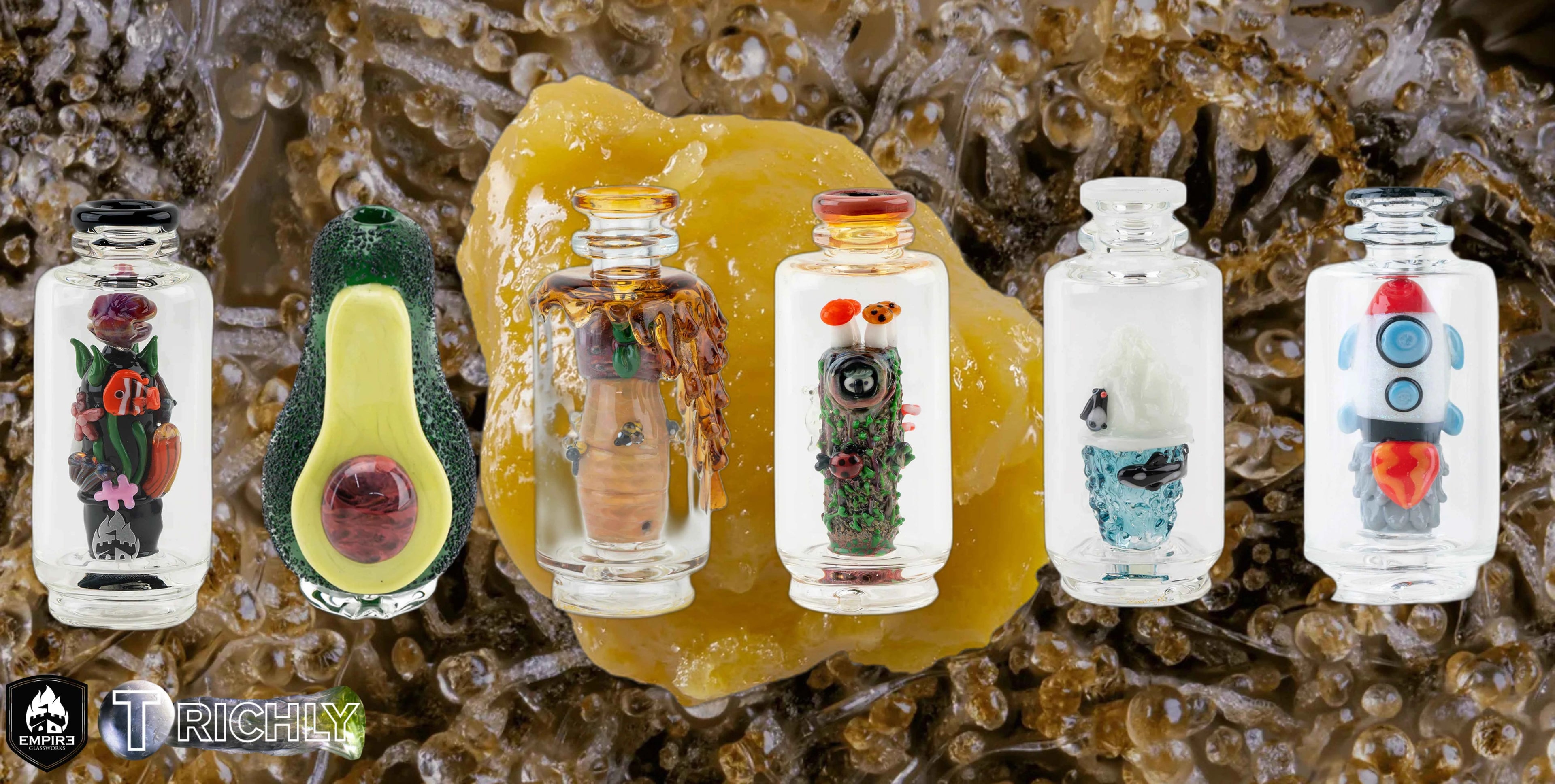Pros, Cons, Flavor & Potency
Concentrates compress the cannabinoids and terpenes of flower into potent forms that highlight different effects and flavors. This guide compares major extraction methods, how they affect potency and terpene retention, and the tradeoffs between solvent-based and solventless concentrates.
Quick overview
- BHO — Butane Hash Oil, a hydrocarbon extraction often used to make live resin, shatter, wax and more.
- CO₂ — Supercritical or subcritical carbon dioxide extraction, common in commercial operations for its tunability and safety profile.
- Ethanol — Polar solvent used when full-spectrum extraction and high throughput are needed.
- Solventless — Mechanical methods like rosin, bubble hash and dry sift that use pressure, heat, or ice water instead of chemicals.
BHO (Butane Hash Oil)
What it is: BHO uses light hydrocarbons, usually butane or propane, to dissolve trichome oils from plant material. After extraction, the solvent is purged under vacuum and heat to produce textures from shatter to budder to live resin.
Potency and flavor: Properly made BHO products commonly test very high for THC, often in the 60–90% range for some products1. Hydrocarbon extracts are prized for excellent terpene retention and lively flavor when produced from fresh frozen material2.
Pros:
- Excellent terpene preservation, especially with fresh frozen starting material.
- Versatile textures and product types.
- High potency possible.
Cons and safety notes:
- Butane is flammable. Open-air "blasting" at home is extremely dangerous; commercial operations use closed-loop systems and proper ventilation3.
- If not purged properly, residual solvents will remain; regulated lab testing is important3.
CO₂ Extraction
What it is: Supercritical or subcritical CO₂ is used as a tunable solvent. By adjusting temperature and pressure, extractors can target specific cannabinoids and terpenes. CO₂ is nonflammable and considered industrially safe4.
Potency and flavor: CO₂ extracts can be clean and consistent. Terpene capture varies by process settings; supercritical modes extract more total cannabinoids but may require extra steps to maximize terpene retention compared to cold hydrocarbon methods5.
Pros:
- Nonflammable and scalable for commercial production.
- Highly tunable selectivity via pressure and temperature control.
- Good for consistent, regulatory-friendly products.
Cons:
- High capital cost for equipment.
- May be less effective at extracting certain volatile terpenes unless processes are optimized or cold fractions are used5.
Ethanol Extraction (brief)
Ethanol is widely used for large scale, full-spectrum extraction. It is polar so it pulls a broad profile of plant compounds. Winterization is often required to remove fats and waxes. Ethanol workflows excel when throughput and solvent recovery are priorities5.
Solventless Methods
What they are: Methods such as rosin (heat + pressure), bubble hash (ice water separation), and dry sift use mechanical action and temperature rather than chemical solvents to collect trichomes. Solventless concentrates are celebrated for a "pure" plant-forward taste6.
Potency and flavor: Solventless can be extremely flavorful and full spectrum when starting material is high quality. THC% may be high, but often slightly lower than distilled solvent extracts because solvent processes can pull more total cannabinoids into a single product1, 6.
Pros:
- Perceived as clean and natural; no solvent residues by definition.
- Excellent for preserving a plant’s characteristic flavor profile when starting material is exceptional.
Cons:
- Yields are typically lower than solvent methods; production is often more labor intensive.
- Quality is highly dependent on starting material and technique.
Solvent versus Solventless — a direct comparison
Flavor: Hydrocarbon extracts such as BHO often retain very high terpene levels and deliver strong flavor when made from fresh frozen material. CO₂ can be tuned to preserve terpenes but may require more precise fractionation to match hydrocarbon flavor profiles. Solventless shines at delivering a "true to flower" taste when the starting material is exceptional2, 5, 6.
Potency: Solvent methods commonly reach the highest measured cannabinoid percentages. Solventless concentrates are potent but may register slightly lower overall cannabinoid concentration while offering a richer full spectrum mouthfeel1, 6.
Safety and contaminants: All solvent processes require proper purging and lab testing for residual solvents. Regulators and accredited labs screen for solvents, pesticides, heavy metals, and microbials to ensure safety. Solventless avoids solvent residues but still requires testing for pesticides, molds, and other contaminants3.
Common flavor / terpene notes by concentrate type
- Live resin / BHO: bright citrus, fruity, fuel or diesel, fresh floral notes. Often highly aromatic due to trapped volatile terpenes2.
- Rosin / solventless: earthy, herbal, creamy or doughy notes depending on starting flower; can feel fuller and more plant like6.
- CO₂ extracts: clean, balanced, sometimes less punchy terpene profile unless cold fractionation is used5.
Buying tips
- Always check for third party lab test results showing cannabinoid profile and residual solvent testing. If lab results are not available, treat that as a red flag3.
- For flavor, look for products made from fresh frozen or "live" material if you want terpene-forward concentrates.
- If you prefer an all-mechanical product, seek labeled rosin or bubble hash from reputable makers and check lab results for pesticides and microbiology6.
Conclusion
There is no single "best" concentrate. BHO and other hydrocarbon extracts often deliver top terpene preservation and very high potency when made safely in closed systems. CO₂ is a safer industrial solvent that is tunable and clean. Solventless methods offer a plant-forward experience and avoid solvent residues at the cost of lower yields and higher labor. Prioritize lab testing, reputable sourcing, and storing concentrates correctly to keep flavor and potency intact.
Sources
- Utah Canna — What is BHO
- Royal Queen Seeds — Solvent vs Solventless
- PMC — An assessment of solvent residue contaminants related to cannabis extracts
- ExtraktLAB — Supercritical Fluids Extraction overview
- PMC — Supercritical Carbon Dioxide Technology for Recovering Valuable Compounds
- Jetty Extracts — Solventless vs Solvent-Free

0 comments